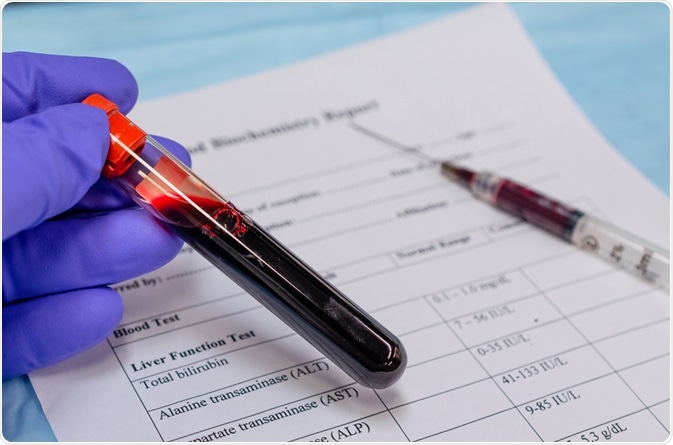A study published in the Journal of Clinical Medicine has reported on the functional relationship between serum creatine kinase (CK) and liver biochemistry to determine the accuracy of liver function tests in the assessment of rhabdomyolysis.
 Image Credits: Manjurul Haque / Shutterstock.com
Image Credits: Manjurul Haque / Shutterstock.com
The research team behind the study found that there was a statistically significant positive linear relationship between creatine kinase and alanine aminotransferase (ALT) amongst a range of associations explored.
This provides evidence that the increase in alanine aminotransferase can be anticipated on the basis of peak CK.
Rhabdomyolysis: Biomarkers to assess its severity
Rhabdomyolysis is a condition of muscle breakdown experienced in response to injury. The breakdown of muscle results in the release of cellular contents into the blood. The effects of this are far-ranging, resulting in cardiac arrhythmia and acute kidney injury (AKI) as a result of modified ion levels in the body.
Alongside this effect is the release of enzymes including creatine kinase (CK), lactate dehydrogenase, and aldolase. A clinical indicator of the severity of rhabdomyolysis is serum CK concentration. Most studies diagnose the syndrome when CK levels are present at five times above the upper limit of normal (1000 U/L).
The relevance of aminotransferases such as aspartate aminotransferase (AST) and alanine aminotransferase (ALT) to the diagnosis rhabdomyolysis, however, is underappreciated. Both are transiently increased in rhabdomyolysis, but ALT is a more specific indicator of liver despite both being distributed in other tissues.
ALT is 1-10 times more prevalent in the liver relative to other tissues. Given that adults only possess 20-30 Kg of skeletal muscle mass, relatively small amounts of ALT in the muscle may be detected at scale in the blood in instances where large muscle groups are injured.
The need to assess the relationship between liver biochemistry and CK levels: drawing quantitative inference
The association between abnormal liver tests and rhabdomyolysis is unclear. Implications of this association may be adverse; from the false attribution of elevated aminotransferases to liver injury and invasive liver biopsies. Conversely, a failure to appreciate this association may lead to a missed diagnosis of muscle, rather than liver disease.
In addition, clinical trials of drugs with hepatotoxicity have complicated outcomes when subjects experience elevated serum aminotransferases from exercise-induced muscle damage. This has motivated the need to examine the relationship between liver biochemistry and CK levels in patients with severe rhabdomyolysis.
The results of log-transforming variables of liver biochemistry to quantify relationships
The group selected 528 patients with pressure injuries, the major mechanism of rhabdomyolysis.
The group found that peak CK and log ALT could be positively correlated among other biomarkers tested. The clinical implications of the relationship between peak CK and ALT are important.
Peak CK can be used to anticipate the increase in ALT in patients suffering from rhabdomyolysis. In cases where ALT lies outside the upper 95% confidence interval of the predicted ALT expected for a given peak CK, liver injury is suspected.
In practice, this would translate as a patient with a peak CK of 100,000 U/L without AKI or chronic liver disease possessing less than a 5% probability of returning an ALT above 200 U/L.
Other variables that showed a negative correlation with log-ALT were also discovered; these included patient age, the severity of AKI and Chronic kidney disease (CKD) stage. Chronic liver disease. Contrastingly the effect of age, AKI and chronic liver disease on log ALT were minor.
Of the other suspected biomarkers of liver disease tested, there was no correlation found between the log-creatine kinase and the log-bilirubin, log-alkaline phosphatase, or log-γ-glutamyl transferase.
Strengths and limitations
This study represents the first to determine the relationship between the variables that are known or assumed to complicate the association between CK and ALT. However, the study was limited by the lack of data on AST. Moreover, in the absence of baseline liver function, it was not possible to determine whether an elevated ALT may be a pre-existing problem in some patients.
In some cases, abnormal ATL was transient and was normalized upon patient discharge. Information concerning the timings of discharge, histological data, and availability of biochemistry was also lacking, limiting data. Most notably, the predicted level of ALT may have been underestimated as previous studies suggest that peak ALT typically occurs 24–48 h after peak CK.
Source
Lim, AKH et al. (2020) A Cross-Sectional Study of the Relationship between Serum Creatine Kinase and Liver Biochemistry in Patients with Rhabdomyolysis. J. Clin. Med. Doi: 10.3390/jcm9010081
Further Reading
- All Biomarker Content
- Biomarker – What is a Biomarker?
- Procalcitonin and Respiratory Tract Infections
- Heart Disease Biomarkers and Screening Tests
- New Biomarkers for IBS could be Used to Offer Non-Invasive Diagnosis
Last Updated: Mar 16, 2020

Written by
Hidaya Aliouche
Hidaya is a science communications enthusiast who has recently graduated and is embarking on a career in the science and medical copywriting. She has a B.Sc. in Biochemistry from The University of Manchester. She is passionate about writing and is particularly interested in microbiology, immunology, and biochemistry.
Source: Read Full Article
